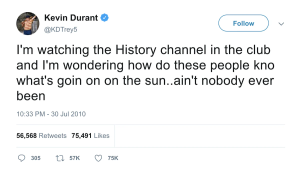3 Analyzing Cultural Literacy
Cultural Literacy for Writers
As Part I indicated, cultural literacy for writers evolves from utilizing scholarly language and extensive research to build authorial credibility and solidify effective persuasion of the intended audience. Writers can bridge the gap between rhetoric and cultural literacy by engaging with everyday media and then rhetorically analyzing them. We are always performing rhetorical acts. When we read a book, watch a movie, or even post a comment on social media, we are part of an audience and are being persuaded to read, watch, or take action.
When writers understand that rhetoric is the act of persuasion, they also realize that each piece of media they engage with persuades them to return and engage with it further. In short, they realize the power of persuasion. Importantly, media you engage with are part of a cultural literacy you understand, and you can use the rhetorical situation to identify their messages, who is delivering those messages, and whether they are effective means of persuasion. From here, analysis of cultural literacy can then be decoded for its message and articulated in later writing.
Analyzing Media Rhetorically (Media Inform Argument)
The first step in rhetorical analysis is to assess the piece of media that is produced. As addressed in the chapter “What Is Rhetoric?,” writers should analyze the rhetorical situation through application of ethos, pathos, logos, and kairos, asking themselves:
- Who is delivering the message?
- What is the message about?
- How does it make me feel?
Writers can apply this formula to any piece of media and conceive a viable argument about what the communicator is saying and how that message makes the audience feel so that they can analyze the effectiveness of the message. Writers can also enhance their learning by engaging in cultural literacy that is utilized on a daily basis to determine how to rhetorically analyze it.
It is critical to note that when breaking down the rhetorical situation, various steps must be taken to ensure that there is a thorough digest of the overall meaning and its result for the audience. The examples outlined below offer practical guidance on analysis by breaking down the rhetorical situation, analyzing for credibility, and then decoding the message based on cultural literacy.

Take, for instance, this post on Twitter (now X) by Kevin Durant. He is using the social media platform to make an argument that historians do not exactly know about the sun. This is what this piece of media says at face value. The first step in analysis is to break down the rhetorical situation: who is the communicator, what is their message, and who is the audience?
Rhetorical Analysis 3.1.
Breakdown Example 1
Communicator: Kevin Durant
Message: Historians do not factually know what the sun is like because they’ve never been there
Audience: His Twitter followers; possibly people who are not following him; people who may believe this message to be funny.
When we develop the rhetorical analysis of the tweet, it is critical to note that what we see at face value, above, is our initial perception, but the second step involves research into the background of Durant and the context in which the tweet was written. The third step is developing a critical analysis, based on both initial impressions and research, that reflects the interpretation of the message and whether it makes the communicator credible.
Rhetorical Analysis 3.2.
Breakdown Example 2
Communicator: Kevin Durant, basketball player, former college student
Message: Historians do not factually know what the sun is like because they’ve never been there. Delivered via Twitter at 10:33 PM, in the club, as stated by Durant. The History Channel is known to not be as credible.
Audience: His Twitter followers; possibly people using Twitter who are not following him. People who are following him might agree with his statement due to biases or their own perception that this statement is true. Others might not think much of it and solely think it is funny. The unintended audience might discredit his statement due to his profession as a basketball player, or might agree with him due to their own knowledge of the statement. The unintended audience might also think it is funny while discrediting him because he is a basketball player.
As you develop your analysis of a piece of media, keep in mind the communicator’s purpose—what they are persuading you of—and whether or not they succeeded in the act of persuasion. In other words, you’re analyzing rhetoric! After evaluating rhetorical effectiveness by decoding the cultural literacy of the piece’s message based on what you know or learned through analysis, convey your interpretation of the message in a rhetorical analysis (for an example, see the section “Annotated Example”).
Activity 3.1.
DECODING: identifying to outline
Use the following outline to help create an analysis of everyday media.
Identify your Communicator (Character, author, musical artist)
- How do they establish ethos?
- What is their background information? (History in subject matter, cultural upbringing, profession)
- What does your communicator want?
Identify the Message of your media
- What logic is used to deliver message? (Facts, statistics, ethos from the message itself)
- What examples do they use to attest to what they want?
Identify Audience
- How does the communicator appeal to audience’s emotions?
- How does the message move you? (Outline adjectives)
- What significant quotes can you recall?



